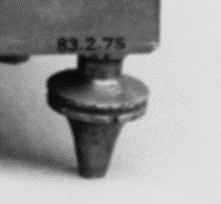Clocks
Feet
George Washington clocks utilize a variety of feet. The "standard" foot used on the great majority of clocks can be seen in Example 1 below, and can best be described as a "lozenge" form that screws into the clock base at each of the four corners. These feet feature a band of spiraled beading around the mid-section, and when polished to a mirror finish, the top and bottom bands stand out and pop against the satin finish of the mid-section. The Winterthur clock in Entry #1 is a good example of this effect.
Examples 2 and 3 below are a variation on the lozenge form. These feet are more ball-shaped and raise the clock base slightly higher than clocks utilizing lozenge fet. The acanthus leaves at the top of the ball in example 3 mirror the acanthus leaves used on the clock case that can be seen in Entry #X.
Examples 4, 5, 6 and 7 are representative of the types of feet used on the smaller clocks. Whether it's due to their diminutive size, it can be generally said that the smaller the clock, the more distinctive the feet. Example 8 is the foot on the bust clock that can be seen in Entry #Y.
Of the total number of cataloged clocks in the Entries section, X have lozenge feet and Y have ball feet.








